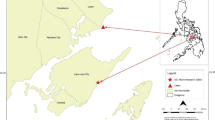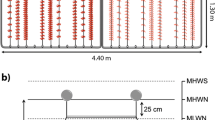Abstract
The commercial exploitation of seaweeds largely depends on success of consistent biomass production. The present study demonstrates technical feasibility for rapid production of viable seedlings clonally through selective propagation of apical fragments of Gracilaria dura. The highest regeneration was recorded at 25 psu salinity, 5 μmol photons m−2 s−1 irradiance and 25 °C where it ranged between 80.83 ± 3.95 and 28.77 ± 2.03 %. The percentage growth in vertical polythene-tube-column culture was ranged between 40.298 ± 27.25 and 55.687 ± 19.39 % and found to be effective in producing large numbers of seedlings. These seedlings showed fast acclimation to outdoor culture and recorded growth rates of 1.37 to 2.25 % day−1 after 1 month. The seedlings grew rapidly when outplanted in open sea with growth rates of 3.06–3.29 % day−1, comparable to commercial farming of Kappaphycus alvarezii along the southeast coast of India. The average length of harvested plants was found to be 7.71 ± 0.89 cm, while fresh weight was 34.60 ± 9.81 g. Further study to understand seasonal variation in regeneration and growth is imperative to scale-up the methodology for year-round production.



Similar content being viewed by others
References
Al-Hafedh YS, Alam A, Buschmann AH, Fitzsimmons KM (2012) Experiments on an integrated aquaculture system (seaweeds and marine fish) on the Red Sea coast of Saudi Arabia: efficiency comparison of two local seaweed species for nutrient biofiltration and production. Rev Aquaculture 4:21–31
Bezerra AF, Marinho-Soriano E (2010) Cultivation of the red seaweed Gracilaria birdiae (Gracilariales, Rhodophyta) in tropical waters of northeast Brazil. Biomass Bioenergy 34:1813–1817
Bixler HJ, Porse H (2011) A decade of change in the seaweed hydrocolloids industry. J Appl Phycol 23:321–335
Buschmann AH, Westermeier R, Retamales CA (1995) Cultivation of Gracilaria on the sea-bottom in southern Chile: a review. J Appl Phycol 3:291–301
Cirik Ş, Çetin Z, Ak İ, Cirik S, Göksan T (2010) Greenhouse cultivation of Gracilaria verrucosa (Hudson) Papenfuss and determination of chemical composition. Turkish J Fish Aqu Sci 10:559–564
Collantes G, Melo C, Candia A (2004) Micropropagation by explants of Gracilaria chilensis Bird, McLachlan and Oliveira Gloria. J Appl Phycol 16:203–213
Collantes G, Melo C (1995) Cultivo de tejidos y células de algas marinas. In: Alveal K, Ferrario ME, Oliveira EC, Sar E (eds) Manual de Métodos Ficológicos. Universidad de Concepción, Concepción Chile, pp 457–477
Eswaran K, Ghosh PK, Siddhanta AK, Patolia JS, Periyasamy C, Mehta AS, Mody KH, Ramavat BK, Prasad K, Rajyaguru MR, Reddy CRK, Pandya JB, Tewari A (2004) Integrated method for production of carrageenan and liquid fertilizer from fresh seaweeds. US Patent 6983479
FAO (2013) Social and economic dimensions of carrageenan seaweed farming, (Eds.) Valderrama D., Cai J, Hishamunda N., Ridler N. FAO Fisheries and Aquaculture Technical paper 580:204 pp
Ganesan M, Sahu N, Eswaran K (2011) Raft culture of Gracilaria edulis in open sea along the south-eastern coast of India. Aquaculture 321:145–151
Ghosh PK, Mody KH, Reddy MP, Patolia JS, Eswaran K, Shah R, Barot B, Gandhi MR, Mehta AS, Bhatt AM, Reddy AVR (2007) Low sodium salt of botanic origin. US Patent 7208189
Ghosh PK, Siddhanta AK, Prasad K, Meena R, Bhattacharya A (2006) Process of preparation of biodegradable films from semi refined kappa carrageenan. US patent 7067568
Gupta V, Baghel R, Kumar M, Kumari P, Mantri VA, Reddy CRK, Jha B (2011) Growth and agarose characteristics of isomorphic gametophyte (male and female) and sporophyte of Gracilaria dura and their marker assisted selection. Aquaculture 318:389–396
Guillemin ML, Faugeron S, Destombe C, Viard F, Correa JA, Valero M (2008) Genetic variation in wild and cultivated populations of the haploid diploid red alga Gracilaria chilensis: how farming practices favor asexual reproduction and heterozygosity. Evolution 62:1500–1519
Halling C, Aroca G, Cifuentes M, Buschmann AH, Troell M (2005) Comparison of spore inoculated and vegetative propagated cultivation methods of Gracilaria chilensis in an integrated seaweed and fish cage culture. Aquacult Int 13:409–422
Hernández-González MC, Buschmann AH, Cifuentes M, Correa JA, Westermeier R (2007) Vegetative propagation of the carrageenophytic red alga Gigartina skottsbergii Setchell et Gardner: indoor and field experiments. Aquaculture 262:120–128
Holdt SL, Christensen L, Iversen JJL (2014) A novel closed system bubble column photobioreactor for detailed characterisation of micro- and macroalgal growth. J Appl Phycol 26:825–835
Huang W, Fujita Y (1997) Callus induction and thallus regeneration in some species of red algae. Phycol Res 45:105–111
Huddy SM, Meyers A, Coyne V (2013) Protoplast isolation optimization and regeneration of cell wall in Gracilaria gracilis (Gracilariales, Rhodophyta). J Appl Phycol 25:433–443
Iima M, KinoshitaT KS, Migita S (1995) Cultivation of Grateloupia acuminata (Halymeniaceae, Rhodophyta) by regeneration from cut fragments of basal crusts and upright thalli. J Appl Phycol 7:583–588
Kaczyna F, Megnet R (1993) The effects of glycerol and plant growth regulators on Gracilaria verrucosa (Gigartinales, Rhodophyceae). Hydrobiologia 268:57–64
Kaliaperumal N, Jayasankar R, Ramalingam JR (2003) Outdoor culture of agar yielding red alga Gracilaria edulis (Gmelin) Silva. Seaweed Res Util 25:159–162
Krishnan M, Narayanakumar R (2013) Social and economic dimensions of carrageenan seaweed farming in India. In: Valderrama, D., Cai, J., Hishamunda N., Ridler, N. (eds.) Social and economic dimensions of carrageenan seaweed farming. FAO Fisheries and Aquaculture Technical Paper 580:163–184
Kumar GR, Reddy CRK, Jha B (2007) Callus induction and thallus regeneration from callus of phycocolloid yielding seaweeds from the Indian coast. J Appl Phycol 19:15–25
Mantri VA (2009) Studies on biology of Gracilaria dura (C. Agardh) J. Agardh. PhD Thesis, Bhavnagar University, Bhavnagar, India pp 150
Mantri VA, Thakur MC, Kumar M, Reddy CRK, Jha B (2009) The carpospores culture of industrially important red alga Gracilaria dura (Gracilariales, Rhodophyta). Aquaculture 297:85–90
Meena R, Chaudhray JP, Agarwal PK, Maiti P, Chatterjee S, Raval HD, Agarwal P, Siddhanta AK, Prasad K, Ghosh PK (2014) Surfactant-induced coagulation of agarose from aqueous extract of Gracilaria dura seaweed as an energy-efficient alternative to the conventional freeze–thaw process. RSC Adv 4:28093–28098
Oliveira EC, Aiveal K, Anderson JR (2000) Mariculture of the agar-producing Gracilarioid red algae. Rev Fish Sci 8:345–377
Periyasami C, Anantharaman P, Balasubramanian (2014) Social upliftment of coastal fisher women through seaweed (Kappaphycus alvarezii (Doty) Doty) farming in Tamil Nadu, India. J Appl Phycol 26:775–781
Polne-Fuller M, Gibor A (1987) Calluses and callus like growth in seaweeds: induction and culture. Hydrobiologia 151/152:131–138
Provasoli L (1968) Media and prospects for the cultivation of marine algae. In: Hattori A, Watanabe A (eds) Cultures and Collections of Algae. Japanese Society Plant Physiology, Hakone, pp 63–75
Santelices B (2001) Implications of clonal and chimeric-type thallus organization on seaweed farming and harvesting. J Appl Phycol 13:153–160
Siddhanta AK, Meena R, Prasad K, Ramavat BK, Ghosh PK, Eswaran K, Thiruppathi S, Mantri VA (2005) A cost effective process for preparing agarose from Gracilaria spp. US Patent Application 2005/0267296A1
Titlyanov EA, Titlyanov TV, Kadel P, Lüning K (2006a) Obtaining plantlets from apical meristem of the red alga Gelidium sp. J Appl Phycol 18:167–174
Titlyanov EA, Titlyanov TV, Kadel P, Lüning K (2006b) New methods of obtaining plantlets and tetraspores from fragments and cell aggregates of meristematic and submeristematic tissue of the red alga Palmaria palmata. J Exp Mar Biol Ecol 339:55–64
Yokoya NS, Guimaraes MPBS, Handro W (1993) Development of callus like structures and plant regeneration in thallus segments of Grateloupia filiformis Kutzing (Rhodophyta). Hydrobiologia 260/261:407–413
Young HY, Phang SM, Reddy CRK, Khalid N (2014) Production of clonal planting materials from Gracilaria changii and Kappaphycus alvarezii through tissue culture and culture of G. changii explants in airlift photobioreactors. J Appl Phycol 26:729–746
Yong YS, Yong WTL, Anton A (2013) Analysis of formulae for determination of seaweed growth rate. J Appl Phycol 25:1831–1834
Acknowledgments
The financial assistance from Council of Scientific and Industrial Research, New Delhi is greatly acknowledged. The initial funding for clonal propagation was received from the Department of Biotechnology, New Delhi (BT/PR/6266/AAQ/03/251/2005). This work has been undertaken as a part of an in-house project entitled “Scaled-up farming for technology demonstration of promising seaweeds.” We would like to thank anonymous referees and Prof. Borowitzka for constructive comments. Thanks are due to Dr. K. Eswaran and Dr. C. R. K. Reddy for discussion on cultivation and clonal propagation, respectively. This contribution has CSIR-CSMCRI PRIS Registration No.: 062/2014.
Author information
Authors and Affiliations
Corresponding author
Electronic supplementary material
Below is the link to the electronic supplementary material.
ESM 1
(DOCX 953 kb)
Rights and permissions
About this article
Cite this article
Saminathan, K.R., Ashok, K.S., Veeragurunathan, V. et al. Seedling production in the industrially important agarophyte Gracilaria dura (Gracilariales, Rhodophyta). J Appl Phycol 27, 1541–1548 (2015). https://doi.org/10.1007/s10811-014-0450-z
Received:
Revised:
Accepted:
Published:
Issue Date:
DOI: https://doi.org/10.1007/s10811-014-0450-z




